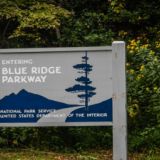Fall Colors in the Great Smoky Mountains! 2016 Autumn Color Forecast and Guide
It’s beginning to look a lot like Autumn! We’re ready for the big show of fall colors in the Great Smoky Mountains and we’ve got your 2016 Autumn Color Forecast and Guide so you can get the most out of Leaf-Peeping Season in the Smokies!
Most folks want to know when is the “peak” of the fall color in the Smokies? Well, the answer is that it depends on just where you are at a particular time. Luckily, there’s not singular “peak ” in the Great Smoky Mountains. You can experience “peak color” throughout the month of October and on into November because of the range of elevations in the Park. From 875 ft. (at the mouth of Abrams Creek) to 6,643 ft. (at Clingmans Dome) you have several opportunities to view the fall colors at their best.
On this first full day of Autumn 2016, it’s still mostly green in the Highlands with a few pops of color here and there. And great news! Park Rangers report that this could turn out to be a banner year for a big show of color with indications that areas above 5,000 ft. will be looking pretty good in a few weeks.
“Some of our most vibrant seasons have happened after there has been a drought and we get several days of good fall rains and we’ve had some explosions of color after that,” says Dana Soehn a National Park spokeswoman reporting yesterday to WVLT-TV’s Kyle Grainger, “For the first day of fall, we are about where we should be, especially at the lower elevations, but that change is around the corner.”
Former Park Ranger and author Rose Houk writes in her book Exploring the Smokies, “It isn’t frost so much as sunny, clear, warm days combined with a drop in temperature at night, that will produce the finest colors. And in a year when that combination occurs, there is no better place in the world to be than in Great Smoky Mountains National Park.” We couldn’t agree more! And current weather predictions expect a cool down and possible rain within the next week or so!
With 130 different species of trees living in the Great Smoky Mountains National Park, you can plainly see why Autumn in the Smokies is so spectacular! As a general rule, the peak of colors can be at some certain elevation in the Smokies between October 15-30. Here’s your guide to a few of the highlights:
SPRUCE-FIR FOREST (above 4,000 ft.) and NORTHERN HARDWOOD FOREST (4,500 to 6,000 ft.)
@ Newfound Gap, Clingmans Dome and Blue Ridge Parkway
- American Mountain-Ash – This northern species is found only above 5,000 ft. and you can’t miss the bright orange-red berries of this small tree. It can be found in the parking lot of Newfound Gap and in the Clingmans Dome area. It’s said that when the striking fruits appear that the fall colors will soon follow in the highlands.
- Witch-Hobble or Hobblebush – One of the first shrubs to change colors to both yellow and red, even on the same bush. Has large, roundish, heart-shaped leaves and flat clusters of red berries.
- Pin Cherry – This northern species turns a pinkish red and has bright red berries. Also called the Fire Cherry because it needs an area disturbed by fire, windstorm or some other event to become established.
- American Beech – A common tree up to elevations of 5,800 ft. with yellow to orange brown leaves. It’s easy to recognize because of its smooth gray-colored bark. Many small beech’s dry, beige leaves persist throughout the winter.
- Yellow Birch – One of the most dominant trees you’ll see from 3,500 to 5,000 ft., with yellow leaves of course! The bark of this tree is a shiny, yellow-silvery color and peels off in shaggy, papery curls.
- Mountain Maple – This northern species fall color is from orange to red and is common from 3,000 ft. to the highest elevations in the Park. North of the Smokies, the Mountain Maple doesn’t grow as tall and is considered a shrub.
COVE HARDWOOD FOREST (below 4,500 feet) @ Cataloochee Valley, Foothills Parkway East, Greenbrier, and Oconaluftee.
- Sugar Maple – Not only does this wonderful tree yield the sap to make everyone’s favorite maple syrup, its leaves in Autumn turn to vibrant oranges and yellows that wow the eyes. The Sugarlands Valley, between the Sugarlands Visitor Center and and Chimneys Picnic Area was named for the abundance of Sugar Maple trees in the area.
- Red Maple – The Red Maple is probably the most common trees in the Park since it grows at the lowest elevations all the way up to 6,000 ft. Its fall color ranges from yellow to red. Red Maples have red twigs, buds and fruits. You’ll notice this tree’s bright red flowers that bloom from February to April each year.
- Sweet Gum – This tree’s star-shaped leaves and round, spiny fruit make it easily recognizable. It prefers moist areas along streams below 2,000 ft. The Sweet Gum’s fall color can range from yellow to red to purple all on the same tree.
- Yellow Poplar or Tuliptree – One of the most common trees in the Park below 4,000 ft. These trees grow big and straight up so they’re easy to spot. Spectacular stands of giants can be found along Little River Road and Laurel Creek Road. When the sun hits the tree’s leaves just right, they seem to glow a brilliant, golden yellow.
- Black Cherry – The dark fruit of this tree is a favorite of bears. It’s quite common below 5,000 ft. and its bark resembles burnt potato chips. It fall foliage is yellow to red.
PINE AND OAK FOREST @ Cades Cove, Foothills Parkway West
- Scarlet Oak – This tree is named for its striking fall color which a magnificent scarlet red. The Scarlet Oak is found on dry slopes and ridges below 3,500 ft. It’s color is often enhanced by the evergreen backdrop provided by surrounding pine trees.
- Chestnut Oak – This is one of the major species that has replaced the American Chestnut since the blight in the 1920’s. Pure stands of Chestnut Oaks can be found on rocky ridges below 4,000 ft. The large acorns of this oak are enjoyed by wildlife. Fall color can range from yellow to purple red.
- Black Gum – The leaves of the Black Gum turn a remarkable crimson color in Autumn and are a spectacular site at elevations below 5,300 ft. Its recognized by the pinwheel arrangement of its leaves and bluish-black colored berries.
- Sourwood – Honeybees love the tiny white flower clusters of this tree that bloom in July and we love the brilliant red leaves of this tree commonly found at elevations below 4,500 ft.
- Mockernut Hickory – Abundant in Cades Cove and areas below 2,800 ft. The Mockernut Hickory, along with the Hickories in the Park, have beautiful yellow fall foliage.
For updates from the Great Smoky Mountains National Park, connect with them on Facebook GSMNP.












